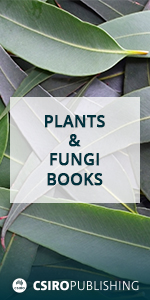
Functional Plant Biology
Volume 41 Number 9 2014
FP14048Crop yield components – photoassimilate supply- or utilisation limited-organ development?
Sucrose production, transport and utilisation are central processes determining crop yield. Their relative quantitative contributions (limitations) to yield are a core plank to direct strategies for crop improvement. Using published responses of a selection of crop species to elevated carbon dioxide concentrations, our analysis demonstrates that numbers in particular and, to a lesser extent potential sizes, of harvested organs are sucrose production/transport (i.e. supply) limited whereas filling these organs is sucrose utilisation limited. These conditions apply across a range of harvested organ types including storage stems and roots, fleshy fruits, grains and tubers.
FP13338Review on shape formation in epidermal pavement cells of the Arabidopsis leaf
Epidermal pavement cells appear with a fascinating irregular wavy shape in the Arabidopsis thaliana leaf. This review addresses the possible biomechanical benefits of this cell shape over other organisations as well as the biomechanical accomplishment of shape and refers to the cell wall and cytoskeletal involvement herein. A current model for pavement cell development integrating genetic and biochemical regulatory pathways is discussed, but remaining questions and pitfalls are put forward.
FP13359Responses of rice to Fe2+ in aerated and stagnant conditions: growth, root porosity and radial oxygen loss barrier
Lowland rice grows in flooded soils which often have low redox potential and high soluble iron (Fe2+), so the effects of Fe2+ concentrations on growth, root porosity and barrier to radial oxygen loss induction were assessed in aerobic and in stagnant conditions. High Fe2+ (0.72 mM) resulted in increased porosity and barrier induction in roots of rice in aerated conditions, whereas in stagnant conditions these root aeration traits were already induced even without addition of high Fe2+. Barrier induction and root aeration would contribute to Fe2+ tolerance in rice.
FP13291Root traits and cellular level tolerance hold the key in maintaining higher spikelet fertility of rice under water limited conditions
Saving and sustaining productivity of rice under water limited conditions is essential to feed the growing population. Better water acquisition coupled with higher cellular level tolerance maintained significantly higher spikelet fertility and thus emphasised the relevance of combining these for improving field level tolerance of rice to water limitation. Such lines can be exploited in breeding to develop superior trait pyramided cultivars. Aerobic cultivation of rice saves water but reduced spikelet fertility causes significant yield loss. We demonstrated that superior roots traits, when combined with higher cellular level tolerance, maintained higher spikelet fertility and yield. The identified trait donor genotypes can be exploited to develop trait pyramided aerobic cultivation worthy cultivars.
FP14046Bark and woody tissue photosynthesis: a means to avoid hypoxia or anoxia in developing stem tissues
In plants, specialised systems for O2 delivery as in animals are lacking. Plant cells are thus frequently challenged with limited oxygen supply. Under illumination, bark and woody tissue photosynthesis rapidly increased plant internal oxygen concentrations and thereby counteracted localised oxygen deficiency (hypoxia). Beneath its role in plant carbon economy, bark and woody tissue photosynthesis may also be important for preventing low-oxygen limitations of respiration in these dense and metabolically active tissues.
FP13299Alterations in stem sugar content and metabolism in sorghum genotypes subjected to drought stress
Sorghum plants store sugar in their stems, besides yielding grain, making it an attractive crop for food and biofuel production. The role of stem sugar accumulation in helping plants cope with drought has been investigated. Stems serve as independent sinks for photoassimilates in addition to the panicle in some genotypes; in others, the stored stem sugars appear to be mobilised to the panicle to augment grain yields in drought-stressed plants.
FP14067Genotype-dependent influence of night-time vapour pressure deficit on night-time transpiration and daytime gas exchange in wheat
The amount of water lost by crops during the night through transpiration can represent a substantial fraction of the daytime water loss, but no efforts have been made to identify possible drought tolerance strategies resulting from such responses. Here we report substantial cultivar-dependent night-time transpirational water losses in wheat, which are dependent on nocturnal evaporative conditions and are strongly related to daytime water loss. These findings open new possibilities for breeding drought-tolerant cultivars based on night-time water use.
FP13302When smaller is better: leaf hydraulic conductance and drought vulnerability correlate to leaf size and venation density across four Coffea arabica genotypes
Coffee productivity and survival are posed at risk by ongoing climate changes. Leaf hydraulic capacity and drought vulnerability are key functional traits influencing plant performance under drought stress conditions. Coffee genotypes with small leaves and high vein length per unit leaf area displayed higher leaf hydraulic efficiency, gas exchange rates and resistance to drought-induced hydraulic dysfunction, with respect to large-leaf cultivars.
FP13370Genetic variability and identification of quantitative trait loci affecting plant growth and chlorophyll fluorescence parameters in the model legume Medicago truncatula under control and salt stress conditions
Salinity is one of the major stresses that limits crop production worldwide and affects most physiological activities in plants. An experiment was undertaken to determine genetic variability in Medicago truncatula, and to identify quantitative trait loci (QTLs). Nineteen QTLs were identified under 100 mm salt stress conditions. The results should be helpful information for further functional analysis of salt tolerance in M. truncatula.
FP14060Post-anthesis heat and a Gpc-B1 introgression have similar but non-additive effects in bread wheat
We examined the effects of a genetic factor (an introgression segment) and an environmental factor (heat) on grain filling in wheat. Both factors accelerated senescence and affected grain protein, but only the heat treatment reduced grain size.
FP14060 Abstract | FP14060 Full Text | FP14060PDF (238 KB) | FP14060Supplementary Material (112 KB) Open Access Article




